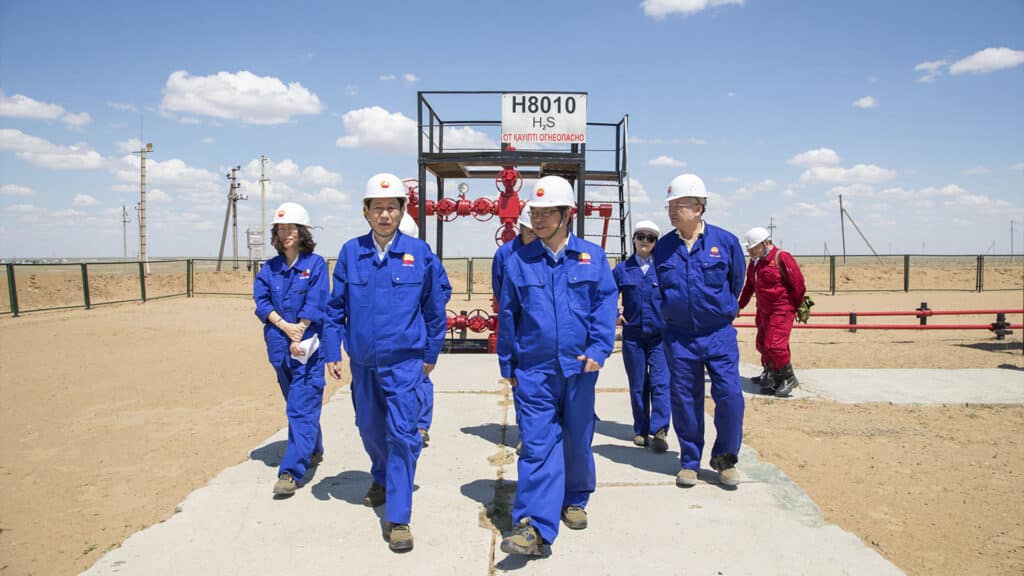CNPC to explore oil in Aktobe region in Kazakhstan

CNPC-Aktobemunaigas, a subsidiary of the China National Petroleum Corporation (CNPC), plans to start exploration work at the Teresken-1 field in the Aktobe region of Kazakhstan in the second quarter of this year. The research will last for 60 days. The company has a license for oil exploration and production in the field for six years.
The company is going to conduct field exploration work to assess the potential of oil and gas reserves in the field as well as the two other oil fields North Truva and Akzhol. The area of 3D seismic exploration will be around 689.19 square kilometers. Target horizons lie 7 to 8 kilometers deep inside the Earth.
As the company noted, a well drilled at the Takyr field with a similar geological structure has shown signs of oil and gas. During a drilling test, an exploring team reported ten cubic meters of oil and 30 cubic meters of water at the well per day. In 2020, 2D seismic exploration also showed that the field is worthwhile for further exploration efforts to clarify the location of promising petroleum deposits.
Aktobeenergoneft has already agreed to supply 2,300 cubic meters of water to CNPS-Aktobemunaigas for the entire period of exploration.
According to an audited financial report, as of December 2022, CNPC-Aktobemunaigas possessed $1.9 billion worth of assets and earned $96 million in profit. In 2022, the company paid $103.5 million in dividends. CNCP Exploration and Development Company Ltd. is the parent company for CNPC-Aktobemunaigas controlled by CNPC. CNPC-Aktobemunaigas is the sole operator for a set of oil fields in the Aktobe region such as Zhanazhol, Kenkiyak post-salt and North Truva and also has contracts for exploring at Teresken-1 and Teresken-2. In addition, KMK-Munai, a subsidiary of CNPC-Aktobemunaigas, possesses licenses for subsoil operation at the Kokzhide, Kumsay and Mortuk fields.
Earlier this week, the prosecutor’s office of the Liaoning Province of China issued a warrant for the arrest of Xu Wenrong, the former deputy general manager of CNPC, who visited CNPC-Aktobemunaigas in 2018. Chinese authorities have accused him of corruption.
On April 24, 2023, Vice President of CNPC and President of PetroChina Huang Yongzhang met with Magzum Mirzagaliyev, CEO of KazMunayGas (KMG), to discuss further cooperation. For instance, the two sides agreed to build a gas processing plant at Kashagan with a capacity of four billion cubic meters of gas per year.
Moreover, the two oil companies discussed the issue of expanding Kazakhstani oil exports to China at the expense of boosting the capacity of the Kazakhstan-China pipeline that stretches through the territory of the two countries.
KMG and CNPC are the key stakeholders of the national oil pipeline system in Kazakhstan. Last year, the Atyrau-Kenkiyak-Kumkol pipeline reported that its capacity was occupied by almost 100%. In 2022, the Atyrau-Kenkiyak pipeline transported 4.5 million tons of oil, while the Kenkiyak-Kumkol pipeline shipped 8.1 million tons of oil.
The two sides also discussed the possible cooperation at new oil fields including Bolshoy Zhambyl and Turgai Paleozoic and boosting the capacity of the Shymkent oil refinery up to 12 million tons per year. Once the expansion of production is completed, the refinery will cover the deficit of fuel caused by growing domestic consumption.
On the other hand, Sanzhar Zharkeshov, CEO of QazaqGaz, visited China where he met with the head of CNPC and discussed practical issues related to the construction of a second gas processing plant at Kashagan, exploration of a new gas field, construction of a second line of the Beyneu-Bozoy-Shymkent gas pipeline and issues associated with gas exports to China.
In particular, Zharkeshov visited a manufacturing site of the HBP company that builds equipment for the Kashagan gas processing plant. The company was supposed to design, produce and deliver this equipment to the site by the end of 2023.

